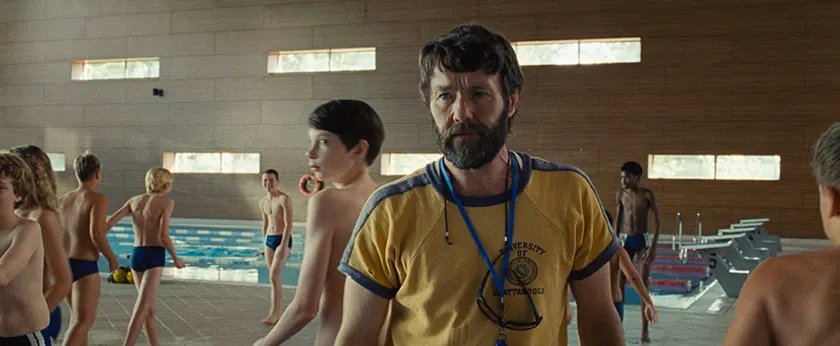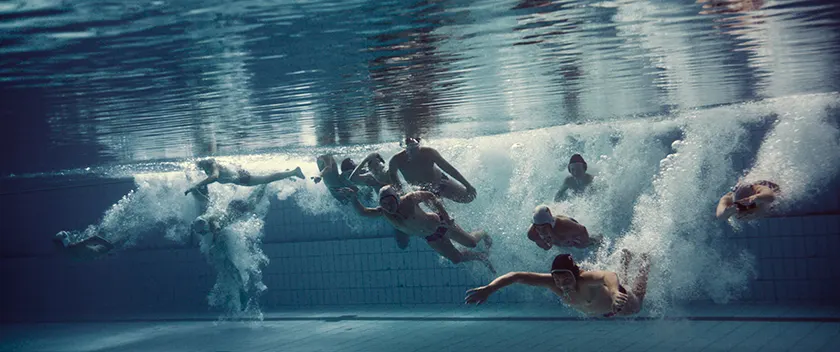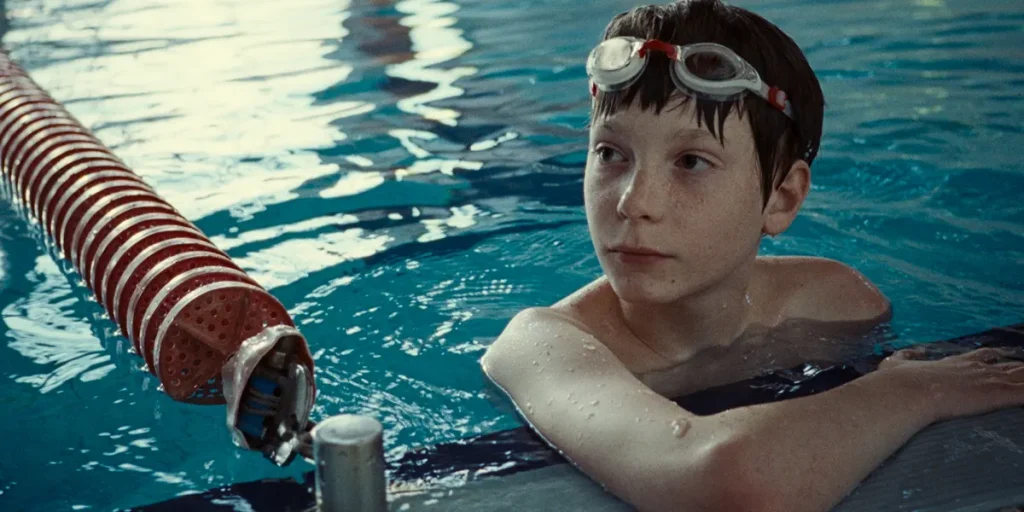The Plague, Charlie Polinger’s beautiful and timely directorial debut about kids at summer camp, grapples with the monstrosity of boyhood.
Writer & Director: Charlie Polinger
Genre: Psychological Horror
Run Time: 95′
Cannes Premiere: May 16-18, 2025 (Un Certain Regard)
Release Date: TBA
Is there really a crisis of masculinity engulfing our culture and stealing our sons? A number of recent releases have used this frightening reality to shape their work, using dark headlines to fuel their creative endeavors. This list includes Charlie Polinger’s claustrophobic and beautiful directorial debut The Plague, which premiered at Cannes 2025 in the Un Certain Regard category.
The film offers a snapshot of boyhood coming of age, following a group of middle schoolers at a summer water polo training camp. Trapped within an uncomfortably familiar looking American school, the boys swim, bond, and inflict unspeakable cruelty.
Our protagonist, Ben (Everett Blunck), has just moved to town, and clearly does not fit in with the others, who are loud, braggadocious, and convinced that one of the campers has a mysterious disease they call “the plague.” Ben is our quiet observer who finds himself pulled into the action, with his friends turning on him and him turning on them in a sickening cycle until the film’s unexpectedly bloody end.
Ben befriends a group of rowdy popular boys led by the fiendishly cruel Jake (Kayo Martin). The gang delights in sprinting as far away as they can from plague victim Eli (Kenny Rasmussen), the camp loner. Eli seems used to the ostracization; he is a proudly nerdy boy who wears a long-sleeved swim shirt around the pool and would rather waltz with a cardboard cutout of a cartoon woman at the school dance than approach one of the girls. His unabashed sense of self both intrigues and repulses Ben, who doesn’t believe in the plague but is terrified when he realizes that the truth doesn’t matter to anyone but himself.
As Ben starts experiencing plague-like symptoms—an itchy red rash and pimples—he begs the others, “The plague isn’t real. There’s nothing wrong with me.” The plague is just the external manifestation of otherness or uncoolness. This horror of physical and emotional exposure permeates the film: there is the constant adolescent fear that something is deeply and irredeemably wrong with you, and everyone else can see it.

Sound, cinematography, and expertly written dialogue weave together to create a near-seamless viewing experience as enthralling as it is horrifying. Powerful drum beats, horror movie strings, and thrumming synths mix with a soundscape, designed by Damian Volpe, that is composed predominantly of water noises: the constant hiss of locker room showers, and the echoes of people in the pool. These noises emphasize the abjection in banal, familiar spaces, especially the locker room. A Carrie comparison comes to mind as we watch the boys shove each other under the frigid spray and pull away from those they believe have “the plague,” their faces contorted in mockery.
Each part of the setting is captured through slow pans or extreme close-ups, and the work of cinematographer Steven Beckon makes it hard to avert your eyes. Washed out locker rooms, shadowy hallways, fluorescent cafeterias, and neon vending machines become horrifying in a flash, quiet pans are interrupted by characters running frantically or shouting menacing words. During our brief moments outside the school, we’re taken to other sites of mundane Americana, like a sticky late-night restaurant that still has a payphone on the wall.
The film brutally returns us to the action through close-ups on micro-behaviors that bring the characters to life, neuroses and all. Many moments focus on Ben’s nervous sideways glances or bloody nail beds while the boys’ jeering and taunts echo in the background. A close-up of his shaky hands smashing the buttons of the payphone shows us how desperate for escape he is. Other shots, like a close-up of a jar of squirming cockroaches, represent the ickiness of adolescence, a time that is both intensely practiced and affected, and yet utterly inevitable and natural.
I could go on about the cinematography; a moment where a character’s bloody face dissolves into the pool’s red floatation devices comes to mind. But the dialogue in Polinger’s script—overlapping, loud, and brutal—is what has stayed with me the most. The film is set in 2003, but the boys’ interactions with each other are, unfortunately, timeless. They posture about how many “bitches” they get and play crude games of would you rather. They sneak out of the school to throw a party that’s really an opportunity to release the tension they can’t express. As they scream, smash old furniture, and break open a water pipe that bursts all over the street, the sense of catharsis is as needed for the viewer after an hour of nonstop tension as it is for the characters.
The dialogue is near constant, yet there’s so much that the boys can never say to each other. Some of the film’s most heart-wrenching moments come when their harsh words clearly don’t align with the expressions on their young, anxious faces. Consider the scene where the boys ask Ben to describe a sexual fantasy about one of the girls at the camp, which he invents on the spot while his eyes dart wildly around the room. At times, through their studiously casual locker room conversations, we glimpse snapshots of fractured lives—parental affairs, divorces, sibling relationships—and the boys’ fears, as is the way of being thirteen, that the overwhelm will never end.

If you yourself have been thirteen—as most of us have been, and will always be, on some level—you will recognize these characters, and hate and feel for them in equal measure. If you’ve played sports or watched the news during the past eight years, the idea of “locker room talk” will be chilling, despite our characters’ youth (They are clearly only play-acting adulthood). But despite this sense of timelessness, there is something that feels especially urgent about watching and discussing this film now.
It seems like every day cultural critics speculate about the so-called “male loneliness epidemic,” or this salivating eagerness to discard “woke” culture. This counter-cultural regression to a more violent and less diverse period in America’s recent past is like a sickness—a plague—that is infecting social media, dating apps, corporate boardrooms. How do we protect young men from such radicalization, and how do we keep young women and members of other historically marginalized groups from suffering the consequences?
It’s a problem that has been exacerbated by uniquely timely threats: social media corporations that profit from promoting violence, grifter influencers who have found a devoted base in disaffected, desperate people, artificial intelligence blurring the line between digital fiction and reality. But as The Plague shows, misogynistic posturing and violence is not a new threat to young men. Instead, it’s a very old one we have never been able to come to terms with, and now must witness worsening before our eyes.
The Plague is not the first creative project of the year to focus on this topic. One recent example is Philip Barantini’s Netflix limited series Adolescence, which follows a middle school boy accused of murdering one of his female classmates. As viewers learn, the boy may have been indoctrinated into what is known as the “manosphere,” an online world of coded misogyny and figurative emojis that everyone, including the police, finds impenetrable. The Plague and Adolescence are not very similar, but the release of both within only a few months reveals an artistic and cultural fascination with this topic, a desperation for a solution as well as the ever present need, and ultimately hopeful endeavor, to mediate difficult discussions through art.
The project is intensely personal for Polinger, who said in an interview with Cannes that it was inspired by journals he kept during a summer camp he attended in 2003. But it’s relevant to situate the film within contemporary discussions about troubled boyhood. The film ends with a depiction of joyful escape from the status quo, even if only for a moment and if only after great violence. Perhaps, then, what makes The Plague stand out in a year of projects and analysis about these issues is the empathy it extends to every character, and the hope it gives us that they can one day break free and live as Ben so clearly wants to, in a kinder and more open way.
The Plague: Movie Plot & Recap
Synopsis:
New kid in town Ben spends the summer at a water polo training camp, where his peers are convinced that the camp loner suffers from a mysterious disease they call “the plague.”
Pros:
- The film’s beautiful cinematography and tightly written script work in tandem to create an utterly immersive viewing experience
- The film is politically timely and thought-provoking
Cons:
- Some scenes can feel long, especially the bloodier moments
The Plague premiered at the Cannes Film Festival on May 16-18, 2025, in Un Certain Regard.

